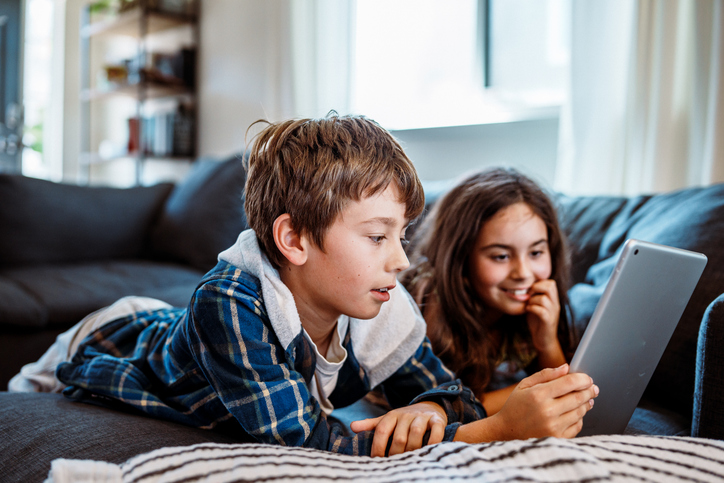When I think back to my own childhood, screens weren’t exactly at the center of my daily life. Sure, there was the television, but it was more of a family event—a shared experience watching cartoons on Saturday mornings or catching the evening news. Fast forward a couple of decades, and now I’m raising kids in an era where screens are everywhere. Phones, tablets, laptops, smartwatches, and even fridges seem to demand our attention. From a dad’s perspective, navigating this “screen age” with my kids has been both fascinating and challenging.
The Balancing Act: Technology as a Tool or a Trap?
Let’s face it—technology is unavoidable. My kids are growing up in a world where screens are integral to how we work, learn, and communicate. For me, the challenge isn’t about keeping them away from screens entirely; it’s about finding the right balance. I want my kids to embrace technology as a tool but avoid falling into the trap of overuse.
Take my eight-year-old, for example. He loves playing educational games on his tablet. Prodigy Math has taught him multiplication tables faster than I ever could with flashcards. My eleven-year-old, on the other hand, uses her laptop for school research and creative writing. Technology has sparked their curiosity and opened doors I couldn’t have imagined at their age.
But, of course, there’s the flip side. The YouTube rabbit holes, endless TikTok scrolling, and the addictive nature of video games are real concerns. I’ve seen how easily “just five more minutes” can turn into an hour of wasted time. There have been times where, as a dad, I’ve had to step in and say, “That’s enough for today.” And let me tell you—it’s not always met with enthusiasm.
Screen Time Struggles: The Negotiations
One thing I didn’t anticipate when becoming a parent in the screen age is how much negotiation would be involved.Screen time has become its own kind of currency in our household. Want to play Roblox after dinner? Sure, but only if homework and chores are done first. Want to binge another episode of that Netflix show? Fine—but not at the expense of family game night.
The tough part is being consistent. Sometimes, after a long day of work, I’m tempted to say, “Fine, just go play on your tablet so I can have five minutes of peace.” But I know that bending the rules too often makes it harder to enforce limits later. So, I’ve had to set clear expectations and stick to them—even when it’s inconvenient.
We also try to make screen time a shared activity whenever possible. Watching a movie together feels different than everyone retreating to their own devices. It’s about making technology a connector, not a divider.
The Social Media Dilemma
As a dad, social media is one of my biggest concerns when it comes to screens. My pre-teen is starting to express interest in platforms like Instagram and Snapchat, which makes me nervous. I know these apps can be a minefield of unrealistic comparisons, cyberbullying, and privacy issues.
Rather than banning social media outright, I’ve decided to take a more proactive approach. We’ve had plenty of conversations about the risks and responsibilities that come with being online. I’ve talked to her about how people often show a highlight reel of their lives on social media, not the full picture. I’ve shown her how to adjust privacy settings and recognize suspicious behavior.
Most importantly, I’ve tried to model healthy habits myself. I can’t expect my kids to limit their screen time if I’m constantly glued to my phone. So, I’ve made an effort to put my device down during meals, family activities, and bedtime routines. It’s not always easy, but I know they’re watching and learning from what I do.
Digital Natives vs. Digital Immigrants
One thing I’ve noticed as a dad is how naturally my kids adapt to technology. They’re what experts call “digital natives,” while I’m more of a “digital immigrant.” They seem to intuitively know how to navigate apps, troubleshoot software, and use devices in ways that sometimes leave me scratching my head.
At first, this gap made me feel a little out of touch. But then I realized it’s an opportunity to learn from them. When my son figured out how to use the family printer better than I could, I didn’t see it as a failure on my part. Instead, I saw it as a chance to encourage his problem-solving skills.
At the same time, I recognize that their proficiency with technology doesn’t always mean wisdom. My job is to teach them how to use technology responsibly, not just effectively.
Setting Boundaries: A Work in Progress
We’ve tried a lot of strategies in our household to manage screen time. Some have worked better than others. For example:
- Time limits: We use parental controls to set daily screen time limits. When the limit is up, the device locks. It’s not always a popular rule, but you know, it’s effective.
- Tech-free zones: We’ve declared the dinner table and bedrooms as tech-free zones. This helps us stay connected as a family and ensures screens don’t interfere with sleep time.
- Scheduled breaks: On weekends, we make sure to balance screen time with outdoor activities. Whether it’s a trip to the park, a bike ride, or just playing catch in the backyard, these breaks are non-negotiable.
Of course, it’s not a perfect system. There are days when the rules go out the window—like when someone’s sick or we’re traveling. And that’s okay. Parenting isn’t about perfection; it’s about progress.
The Upsides of Screens
Despite the challenges, I’ve also come to appreciate the many ways technology has enriched our lives. Screens have helped my kids stay connected with their grandparents through video calls, especially during the pandemic. They’ve used online tools to collaborate with classmates on school projects. And they’ve discovered hobbies like coding and digital art that might not have been possible without access to technology.
Screens have also been a source of bonding for us as a family. We’ve spent countless hours playing video games like Mario Kart and Just Dance together. We’ve had movie marathons and built cities in Minecraft. These experiences remind me that screens aren’t inherently bad—it’s all about how we use them.
Looking Ahead: Preparing Them for the Future
As I navigate parenting in the screen age, I try to keep the big picture in mind. Technology isn’t going away, and my kids will need to be digitally literate to succeed in the future. My role as a dad is to prepare them for that reality.
That means teaching them critical thinking skills to evaluate online information. It means helping them develop self-discipline so they can manage screen time on their own one day. And it means fostering a sense of balance—so they know there’s more to life than what’s on a screen.
Parenting in the screen age isn’t easy, but it’s also an incredible opportunity. By guiding my kids through this digital landscape, I’m not just helping them navigate today’s challenges—I’m equipping them for tomorrow’s possibilities. And as a dad, there’s nothing more rewarding than that.


